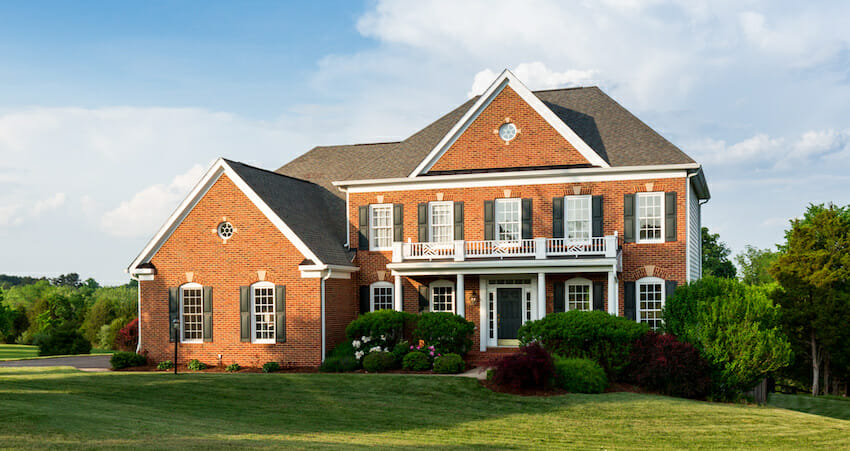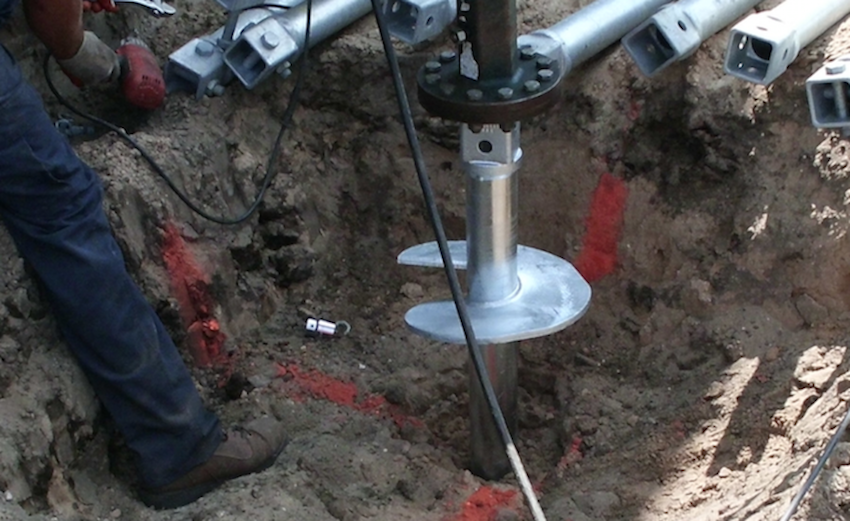Knowing your foundation needs repair can sound daunting to a homeowner. There are many unfamiliar technical terms, and the work itself sounds crazy to the untrained professional. Fortunately, foundation repair does not need to feel daunting!
One of the most important things to understand with foundation repair is knowing what a helical pier is. This pier type is an efficient and powerful tool used to secure many types of foundations and structures. So what exactly is a helical pier, and why should you be confident this will fix your foundation problem? The answer lies in understanding what a helical pier is, how it works, and how these piers are installed in residential structures.
Structure of a Helical Pier

Looking at the diagram, here are the basic design elements you should know about:
A. Footing & Bracket: The footing on this pier is what a structure will rest on. Steel brackets hold the pier and footing in place, securing the structure to the pier.
B. Shaft: The shaft of the helical pier is made of steel. For residential purposes, the pier is typically made of hot-dipped galvanized steel. Shafts are typically 7-feet in length. The length, however, varies according to the specific repair.
C. Helical Plate: This plate is what makes a helical pier unique from other pier types. The plate is what makes this pier essentially an oversized screw. The plates are designed to be load bearing, transferring the weight of your home to the pier.
D. Second Helical Plate: More than one helical plate may be on the pier. The additional plates will depend on the needed load bearing weight, soil composition, and depth. This plate has similar functions to the first helical plate (explained above).
Function of a Helical Pier
Now the we know what a helical pier is, here’s what you need to know about how it works. Its primary function is to lift, level, and secure a foundation. These piers are driven into the ground to help a structure stop moving and/or sinking. You may now be asking, “Why is my home moving to begin with?” Here are a few reasons for moving and sinking foundations, and how a helical pier remedies the situation.
Shifting Foundations
Most people have heard about homes “settling”. This concept is to describe a foundation that is adjusting according to the soil and strata below. This is a normal occurrence until the foundation begins to shift or settle too much. A foundation moves for a variety of reasons, including:
- Expansive soil: Some soil contains a lot of clay that expands and contracts with water. Expansive soil is one of the main reasons a foundation will begin to move. Mother nature plays a big role in this with heavy rains, snow, and drought.
- Soil Compaction: Soil in Michigan must be compacted prior to new construction. Specifications vary by soil type, frost lines, and reaching bedrock or solid strata. If the soil was not compacted properly, or not done at all (for older home built before such codes existed), a foundation may begin to shift under loose soil.
- Poor Drainage: Adequate drainage is another factor that leads to shifting foundation. If the soil and landscaping around a home does not drain properly away from the home, water can pool around a foundation. This can lead to shifting soil and eventually a shifting foundation.
Sinking Foundations
Aside from a foundation moving, it can also begin to sink! The same culprits for a moving foundation play a role in sinking foundations. When the soil underneath your home is compromised, gravity will begin to take a toll. THe weight and gravity lead to a home beginning to sink. Homes will typically sink in certain spots leading to an unleveled home. You may begin to notice signs that your home is not longer level, like:
- Windows and doors that stick
- Cracks along door jambs or window corners
- Leaning chimneys
- Cracks in exterior and/or interior walls
Remedying the Situation
Helical piers are one of the best remedies for foundation issues. Piers are installed at a depth where soil is compact and there is adequate bedrock or solid strata. This soil is less influenced by water, tree roots, and mother nature. Consequently, the foundation is more stable and leveled. Once the pier is driven down to this level, the weight of your home is transferred to the pier instead of resting on the unstable soil.
To put it simply, a helical pier’s function is to hold the weight of your home in place by using the solid strata well below the foundation instead of the unstable soil directly underneath.
Installing Helical Piers
The last part of the ins and outs of helical piers is knowing exactly how these large shafts will be installed. Many homeowners often fret about the potential damage, ruining their landscaping, and wondering if these steel rods can be seen once installed. Here are some answers about helical pier installation that will hopefully put your mind at ease.
The very first step for pier installation is having a free in-home inspection done. Foundation experts will come out to look at the symptoms of disrepair and assess viable solutions for the specific problems. You will be walked through and shown the signs of foundation problems, and an honest explanation of all your options. Your project manager will assess the needs of the foundation, locate the optimal locations for piers, and determine how deep and at what angle the piers should be installed.
Next, crews will come out to your home on the scheduled day. At each pier location, your crew will dig a hole to expose parts of your foundation. Helical piers will be turned into the ground (like a giant screw) to the appropriate load-bearing specifications. Piers will be installed so the footings and brackets are in place, and the weight of your home is shifted to the piers. Crews will work to lift, level, and stabilize your foundation. This will likely also fix those sticking windows and wall cracks.
Last, Kent Foundation Repair crews will backfill the holes and cover the piers. Minimal excavation is required since helical piers are “screwed” in. Backfilling will also occur quickly because helical piers can be utilized immediately and do not have to cure. This means the job can be done with precision and speed!
Feeling Confident about Helical Piers

There is a lot that goes into foundation repair, if it’s done right. These issues are not usually easy DIY weekend projects. But instead of worrying about it, and not understanding how it all works, be sure to equip yourself with knowledge to address those foundation issues. You now know what a helical pier is, how it fixes your foundation issues, and what the installation process will be like. Remember to write down and ask about all your questions and concerns during your in-home assessment so you can feel confident about your crew, the repairs, and the condition of your home. In other words, keep learning and overcoming the seemingly daunting task of foundation repair!


